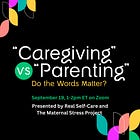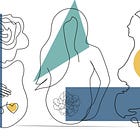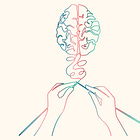“Something has to change.”
There it is. The U.S. Surgeon General, Dr. Vivek Murthy, said it — “something has to change” — in the context of parental stress.
I think we can all agree.
Something does have to change when it comes to the stress of parenting in this country.
In case you missed this announcement, yesterday, Dr. Murthy issued the U.S. Surgeon General’s Advisory on the Mental Health & Well-Being of Parents, calling out the very real stressors that American parents experience. In the Advisory, he discusses how parental stress affects mental health and identifies tangible solutions to implement in order to decrease the stress load on parents.
Of course, there is a lot of stuff in here that struck the right chords for me. Parenting stress is finally getting its due! The solutions include policy making and societal shifts towards better support for parents! I, honestly, did not expect to see this topic picked in this way so quickly. When Dr. Darby Saxbe and I wrote an op-ed in 2021 about how lack of support for parents+caregivers piles on stress and affects American health, friends on the policy side told me we were still miles away from making the case that paid leave, child care policy, etc. could be elevated as health issues.
Yet here we are! The Surgeon freakin’ General says that parenting stress is a hazard to our health!
Seeing the topic play out in this big way was a good reminder that it is time to revisit the stressor map:
And consider some questions: Did Dr. Murthy miss anything? Did I miss anything?
Yes and yes.
Below is my hot take on the Advisory along with an updated version of the stressor map.
(apologies for the rushed writing. I’ll spare you my own personal stress story of writing this in between the madness of the end of summer → back to school but I’m sure you can imagine!)
Where the Surgeon General’s Advisory nailed it:
General
This summary:
“Throughout their lifespan, parents and caregivers often face heightened stressors, including financial strain and economic instability, time demands, concerns over children's health and safety, parental isolation and loneliness, difficulty managing technology and social media, and cultural pressures.”
Acknowledgement of the disproportionate nature of the stress load:
“Stressors related to child caregiving can also disproportionately burden some parents and caregivers, notably those with fewer resources and those who experience economic, social, political, and cultural marginalization.”
There is one thing missing though. He forgot to add “AND mothers”. More on that below…
Sources of parental stress
Financial stress is a BIGGIE with built-in opportunities to reduce the stress load:
“Financial stress related to child care costs, health and education expenses, and employment and income insecurity is an important contributor to parental stress.”
And, again, this stressor disproportionately affects those most at risk for encountering other stressors and those most at risk for facing mental health challenges as a result.
Time pressure as stress! Ooooh…. I feel like this one is nowhere and yet everywhere on the stressor map. Where should it go?! Does unpaid labor load (e.g. child caregiving + family caregiving) cover this enough? Does mental load cover it? Is it a stressor all on its own? Does it go into a special category for its opposition to stress buffers since it takes away time that we might dedicate to leisure and stress-reducing activities? As stated in the Advisory:
“Evidence suggests that demands from both work and child caregiving have come at the cost of quality time with one’s partner, sleep, and parental leisure time. Parents who are also caring for aging parents or other family members face additional strain.”
(Note: in the updated map below, I extended the timeline through the teen years + perimenopause/menopause and added in family caregiving.)
The added stress of parenting a child with medical needs:
“When surveyed, more than twice as many parents and caregivers of children with special health care needs reported ‘fair or poor mental health’ compared to parents and caregivers of children without special health care needs”.
This addition to the parenting stress load is why I’m excited to have a conversation with
, , and Allison Applebaum next month. Join us!Child safety, especially as it relates to gun violence:
“School shootings, or the possibility of one, are a significant source of stress for nearly three-quarters of parents (74%).”
Holy shit that is a large percentage. Can we please DO SOMETHING ABOUT THE GUNS now?
Technology. Oh, technology. I don’t know where this one falls on the stressor map but I feel this statement in my bones:
“Nearly 70% of parents say parenting is now more difficult than it was 20 years ago, with children’s use of technology and social media as the top two cited reasons.”
Where do you think this one lives as a source of stress? Child safety? It’s own stressor node?
The expectations around modern parenting are just too much:
“a modern practice of time-intensive parenting and contemporary expectations around childhood achievement may contribute further to the stressors faced by parents.”
I’ll be exploring this one more in the context of mental load with
. Series starting next week!
What to do now
Tailor interventions:
“Understanding how different populations are affected is vital for tailoring effective interventions and support.”
No notes.
We need more research! Lots of calls for more expansive research in underlying causes of parental stress and inclusion of diverse study participants:
“Researchers should also prioritize the involvement of parents, caregivers, and families with different lived experiences in all stages of research.”
Absolutely true. One problem with this — this call for research does stop short of calling out funders to actually step up the funding for this research. So… not sure what to do with that one. Can’t do research if no one will fund it.
Acknowledgement that there are loads of opportunities to address this issue but it's not easy or quick and requires policy changes and culture shifts:
“Parenting is, by its nature, stressful. By taking steps to mitigate stress at every stage, we can decrease exposure to chronic or severe parental stress, empower parents to meet both the needs of their children and their own, and reduce the likelihood of mental health conditions. Doing so will not be simple. It will require effective policy, strengthened programs, and meaningful culture change.”
Solutions at all the levels:
”Through our individual actions and with the support of community groups, schools, faith organizations, employers, health and social service systems, and policymakers, we can create opportunities for parents to come together and build communities of mutual care and connection.”
YES!
Get on it, policy makers. A menu of options for you, starting with:
Child care –
“policymakers should bolster support for child care financial assistance programs such as child care subsidies and child income tax credits; universal preschool; early childhood education programs such as Early Head Start and Head Start”
Paid Family and Medical Leave –
“Paid family and medical leave would allow for employees to attend to long-term family or medical needs,”
Address economic barriers –
“Priorities should encompass poverty reduction, prevention of adverse childhood experiences, access to affordable neighborhood safety, and improving access to healthy food and affordable housing”
Step up mental health access –
“Ensure parents and caregivers have access to comprehensive and affordable high-quality mental health care.”
What the Surgeon General’s Advisory is missing/lacking:
Mothers vs. fathers. There is very little mention of the disproportionate stress burden settling into the brains of mothers. Yes, parenting stress is a general parental mental health issue. AND parenting stress is also a maternal mental health1 issue and a women’s health2 issue.
Take one example of a stressor used in the Advisory: guilt and shame. The guilt and shame related to modern American parenting disproportionately affects mothers because both of guilt and shame predominantly stem from historical+cultural+societal expectations and gender stereotypes. The feelings are embedded in the social narratives we bathe in daily, as mothers. But none of the disproportionate burden comes across in the mentions of the issue in the Advisory:
“I have found guilt and shame have become pervasive, often leading them3 to hide their struggles, which perpetuates a vicious cycle where stress leads to guilt which leads to more stress.”
Or in the general solutions –
“Open dialogue about these challenges can combat feelings of shame and guilt and cultivate mutual support”.
Or in the individual solutions –
“Setting healthy boundaries that allow one to take such time should not bring guilt or shame but rather be seen as vital actions that can ultimately benefit parents and caregivers as well as their children.”
Not faulting Dr. Murthy on this4, just calling it out to highlight this point: on many levels, parental stress disproportionately affects mothers and we need to see it that way too. More on this below.
I don’t fully accept his definition of stress – “a state of worry or mental tension caused by a difficult situation”. The definition is from WHO and the focus of his advisory is on mental health so I guess I can accept it in this context. I just feel like he could have been more expansive.
Stress affects the whole body and chronic stress can show up as cardiovascular disease, autoimmune disease, metabolic disorders, etc. but I guess this take was mental health focused so that’s where this definition came from? Also, how the heck do you define a “difficult situation”?
The entire section on “The Impact of Parental Mental Health” focuses on the effects on the child, starting with:
“Parental mental health can influence the emotional climate, responsiveness, and consistency of caregiving at home, all of which are crucial for a child’s emotional and cognitive development.”
I’m all for child health, and I do understand why it's tempting to go in this direction (for starters, there is far more research on parental mental health effects on their children), I just don’t like when this topic continues to perpetuate a lopsided circle of parent health —> child health —> parent health.
I also feel like the track record with this research angle (mostly focused on maternal mental health) tends to villainize struggling mothers and sets up solutions that prioritize the child without exactly addressing maternal mental health and wellbeing.
For example, this statement:
“addressing parental mental health conditions, and importantly the underlying stressors and causes, is critical for the well-being of children and society.”
I guess I’m annoyed that there isn’t anything in that specific section to state something along the lines of parents deserve to be healthy too or really anything related to the impacts of adult human health concerns.
Falling into the trap of classic advice around individual stress management. The Advisory does such a great job expanding the problem to the societal and community levels but I still feel like it stops short at the inter-personal level and relies too heavily on personal responsibility for stress management. For example, this statement about what you can do about your parental stress load:
“Remember, caring for yourself is a key part of how you care for your family. Some activities that can help reduce stress include exercise, sleep, a balanced diet, mindfulness, meditation, and recreational activities that bring joy. It can be difficult to prioritize yourself amid the demands of parenting, but even small investments of time in stress-reducing activities can make a meaningful difference.”
Give us our time back and then we’ll talk.
For a more nuanced take on general stress management advice:
What did I miss?
The stressors with older kids is something I did miss entirely with the first version of the stressor map. While I’m not quite sure how to categorize managing technology and social media, I know that gun violence and the category of “scary shit your teen could get into” could be categorized in the child safety stressor node. There is also the teen mental health crisis but I would still include that in the child health stressor node.
Also, the Advisory brings up “cultural pressures” and I’m wondering if that is the same as social narrative?
It also leans into isolation and loneliness. That one was already on the map but I think the issues brought up deserve a close look in the connected context.
Updated stressor map
The biggest thing is that I extended the stressor map through later life and older children5.
This is where I am in life – the zone of elementary aged kids with one rapidly approaching tween-dom, living in a body cruising towards perimenopause, and on the verge of a family caregiving lift that will likely start to pummel me in the coming years.
There is a special kind of “isolation” during this stage of life that I am interested in exploring so I represented it as a “double bubble” — maybe this stress lightens up and resurfaces later with tweens/teens, as currently depicted, or maybe it does stay consistent all the way through? To be investigated! I have a similar “double bubble” thing going on for identity conflict (this one also needs a deeper exploration).
In this new version, I set up a slightly different category, represented in blue – gender neutral stressors related to parenting and family caregiving6. The way ‘parental stress’ is described in the Surgeon General Advisory is important validation AND a reminder that we need to continue discussing the gender differences in stress load. This means isolating the stressors contributing to this general parental stress from those that pile on a disproportionate amount of stress due to personal or societal identification of mother vs father.
Colors that haven’t changed from v1: purple — those stressors that disproportionately affect women and mothers, mostly due to gender-related issues in society or documented gender skew in the load. Black — stressor nodes that reflect stressors related to living in a birthing body – the fertility journey through pregnancy (chosen or not), birth experience, and postpartum. Gray — general stressors in life / modern society that connect to any and all of the above.
All of this to say, there are a LOT of additional opportunities to reduce parental stress that are not mentioned in the Advisory. I completely respect that Dr. Murthy had less than 30 pages to start framing this topic so, of course, he couldn’t cover every little nuance and go down every little rabbit hole to work towards every level of opportunity to reduce this stress load. But I can!
Thank you, Dr. Murthy, I will gladly take that ball and continue running with it!
Did you read the Advisory or any of the coverage (e.g. NYT, WSJ, Time)?
What did you appreciate? What did you find lacking?
The Maternal Stress Project is an educational and idea-spreading initiative and I want it to be available to all so a free subscription will give you access to everything. With that said, this is a beast of a project, so please consider bumping up to a paid subscription if you are able (any little bit counts!). Your generous support will facilitate the growth of the project… and be much appreciated!
Relating to specific addressable stressors during the perinatal period.
Also, I know that paternal mental health is burgeoning as a research field. I don't think it has been tied to parental stress though. I could be wrong. Correct me if I am!
Pertaining to how stress-related illnesses take up a good chunk of the gender health gap.
I would love to know what proportion of “them” refers to mothers vs. fathers. I think this is a very important data point for this specific assertion.
The cynic in me thinks that keeping it neutral allows this issue to appeal more to policy makers, who are mostly dudes and tend to not care very much about women's health.
One addition that is still missing: pain the experience of pain, as a woman. This was brought up in my interview with Carine Carmy:
In a world of equal partnership these stressors are truly gender neutral. I know they are not in our current reality when it comes to heterosexual couples. If I find that these do, in fact, have a societal/cultural reason underlying gender bias that affects stress load, I will switch them back to purple.














My last essay came out either before or hours after this report came out but it explores crisis. I agree with your question, “how the heck do you define a “difficult situation”? I’d love to hear your thoughts on it if you get a chance.
This was super helpful, thank you! Was there any mention of parenting a child with a disability?